Related Research Articles

Mysore, officially Mysuru, is the second-most populous city in the southern Indian state of Karnataka. It is the headquarters of Mysore district and Mysore division. As the traditional seat of the Wadiyar dynasty, the city functioned as the capital of the Kingdom of Mysore for almost six centuries. Known for its heritage structures, palaces, and its culture, Mysore has been called the "City of Palaces", the "Heritage City", and the "Cultural Capital of Karnataka". It is one of the cleanest cities in India according to the Swachh Survekshan.
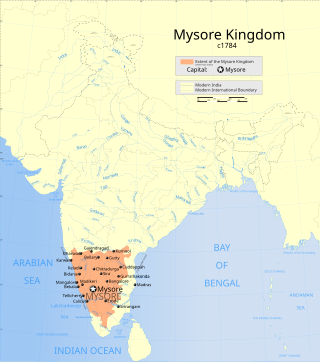
The Kingdom of Mysore was a geopolitical realm in southern India founded in around 1399 in the vicinity of the modern-day city of Mysore and prevailed until 1950. The territorial boundaries and the form of government transmuted substantially throughout the kingdom's lifetime. While originally a feudal vassal under the Vijayanagara Empire, it became a princely state in British India from 1799 to 1947, marked in-between by major political changes.

Raj Bhavan, Karnataka is the official residence of the governor of Karnataka located in Bengaluru city, in the State of Karnataka, India. Constructed in the late 19th century.

Indo-Saracenic architecture was a revivalist architectural style mostly used by British architects in India in the later 19th century, especially in public and government buildings in the British Raj, and the palaces of rulers of the princely states. It drew stylistic and decorative elements from native Indo-Islamic architecture, especially Mughal architecture, which the British regarded as the classic Indian style. The basic layout and structure of the buildings tended to be close to that used in contemporary buildings in other revivalist styles, such as Gothic revival and Neo-Classical, with specific Indian features and decoration added.

Mysore district, officially Mysuru district, is an administrative district located in the southern part of the state of Karnataka, India. It is the administrative headquarters of Mysore division. Chamarajanagar District was carved out of the original larger Mysore District in the year 1998. The district is bounded by Chamrajanagar district to the southeast, Mandya district to the east and northeast, Kerala state to the south, Kodagu district to the west, and Hassan district to the north.

Bengaluru is the capital city of the state of Karnataka. Bengaluru, as a city, was founded by Kempe Gowda I, who built a mud fort at the site in 1537. But the earliest evidence for the existence of a place called Bengaluru dates back to c. 890.
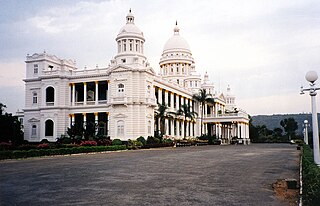
The Lalitha Mahal, now renamed Lalitha Mahal Palace Hotel, is a luxury hotel located in a former royal residence, and the second largest palace in the southern Indian city of Mysore, Karnataka, after the Mysore Palace. It is located near the Chamundi Hills, east of the city. The palace was built in 1921 by Maharaja Krishnaraja Wodeyar IV for the exclusive stay of the Governor-General of India.
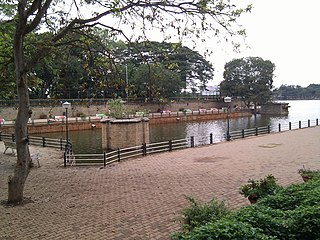
Sadashivanagara is an affluent residential neighbourhood in the northwestern part of Bangalore in the Indian state of Karnataka. It is bounded by Malleshwaram to the west,Vyalikaval and Palace Guttahalli to the south, Palace grounds to the east and Hebbal to the north. The neighbourhood houses plush homes and mansions of several famous celebrities, businessmen and politicians. It is part of the Bangalore North Lok Sabha constituency and the Malleshwaram Assembly Constituency.
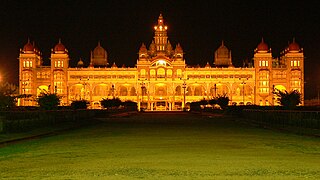
Mysore is a city in the state of Karnataka, India. It is known as the cultural capital of Karnataka. Mysore was the capital of the Wodeyar kings who ruled over the Mysore Kingdom for many centuries. Wodeyars were great patrons of art and music and have contributed significantly to make Mysore a cultural centre. Mysore is well known for its palaces, museums and art galleries and the festivities that take place here during the period of Dasara attract a worldwide audience. Mysore has also lent its name to popular dishes like Mysore Masala Dosa and Mysore Pak. Mysore is also the origin of the popular silk sari known as Mysore silk sari and has also given rise to a popular form of painting known as Mysore painting.

Bangalore Fort began in 1537 as a mud fort. The builder was Kempe Gowda I, a vassal of the Vijaynagar Empire and the founder of Bangalore. King Hyder Ali in 1761 replaced the mud fort with a stone fort and it was further improved by his son King Tipu Sultan in the late 18th century. It was damaged during an Anglo-Mysore war in 1791. It still remains a good example of 18th-century military fortification. The army of the British East India Company, led by Lord Cornwallis on 21 March 1791 captured the fort in the siege of Bangalore during the Third Mysore War (1790–1792). At the time the fort was a stronghold for King Tipu Sultan. Today, the fort's Delhi gate, on Krishnarajendra Road, and two bastions are the primary remains of the fort. A marble plaque commemorates the spot where the British breached fort's wall, leading to its capture. The old fort area also includes King Tipu Sultan's Summer Palace, and his armoury. The fort has provided the setting for the treasure hunt in the book Riddle of the Seventh Stone.
The New Woodlands Hotel is a Udupi-style vegetarian restaurant in Chennai, India. Established in 1938 by Kadandale Krishna Rao, it is considered to be a pioneer in popularizing Udupi cuisine in the city. Since then, a large number of imitations and namesake Woodlands hotels have been established in various parts of Chennai.

Chepauk Palace was the official residence of the Nawab of Arcot from 1768 to 1855. It is situated in the neighbourhood of Chepauk in Chennai, India, and is constructed in the Indo-Saracenic style of architecture.
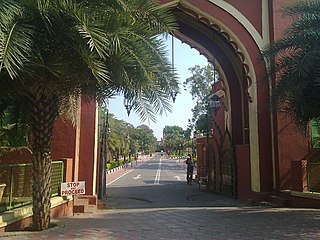
Amir Mahal is the official residence of the titular Nawab of Arcot and his family. Situated in Royapettah, a neighbourhood of Chennai, India, it was constructed in Indo-Saracenic style in 1798, the Amir Mahal has been the residence of the family since 1876. The Prince of Arcot, Nawab Mohammed Abdul Ali, lives in the palace with his family.

Government Museum, Bangalore, established in 1865 by the Mysore State with the guidance of Surgeon Edward Balfour who founded the museum in Madras and supported by the Chief Commissioner of Mysore, L.B. Bowring, is one of the oldest museums in India and the second oldest museum in South India. It is now an archaeological museum and has a rare collection of archaeological and geological artifacts including old jewellery, sculpture, coins and inscriptions. The museum is also home to the Halmidi inscription, the earliest Kannada inscription.
Arni Jagir was a Jagir (estate) and a permanently settled zamindari estate that existed in the North Arcot subdivision of the North Arcot district of the erstwhile Madras Presidency in British India from 1638 to 1948.

Royapettah is a neighbourhood of Chennai, India.
Thiru Vi Ka Salai, or the Thiru Vi Ka High Road, is one of the main streets in the downtown region of Chennai, Tamil Nadu, India. Running from north to south, the street branches off of the arterial Anna Salai north of the LIC Building and ends at Luz Corner in Mylapore, continuing as the Ramakrishna Mutt Road. The street connects the neighbourhoods of Royapettah, Mylapore and Gopalapuram. The street includes three individual stretches formerly known as General Patters Road, Westcott Road and Royapettah High Road, respectively. The longest stretch, formerly known as the Royapettah High Road, runs to a length of 1.17 km (0.73 mi). The presence of numerous automobile dealers on the northern end of the street resulted in Chennai coming to be known as The Detroit of India.
References
- Muthiah, S. (2004). Madras Rediscovered . East West Books (Madras) Pvt Ltd. pp. 67–70. ISBN 81-88661-24-4.